A Critical Appraisal of Medication Administration Error Prevention
VerifiedAdded on 2023/06/12
|8
|2112
|429
Essay
AI Summary
This essay provides a critical appraisal of a research article focusing on medication administration errors (MAEs) and nurses' perspectives on medication safety practices. It examines the research problem, justification, design, and methodology of the study conducted in a tertiary university hospital in the Netherlands. The appraisal highlights the study's findings, including causes of medication errors such as incorrect patient information, barcode limitations, drug labeling confusion, and environmental distractions. It also discusses potential solutions like computerized physician orders, improved drug labeling, and a supportive work environment for nurses. The essay concludes by emphasizing the importance of eradicating MAEs through education, responsible practices, and systemic improvements in healthcare settings.
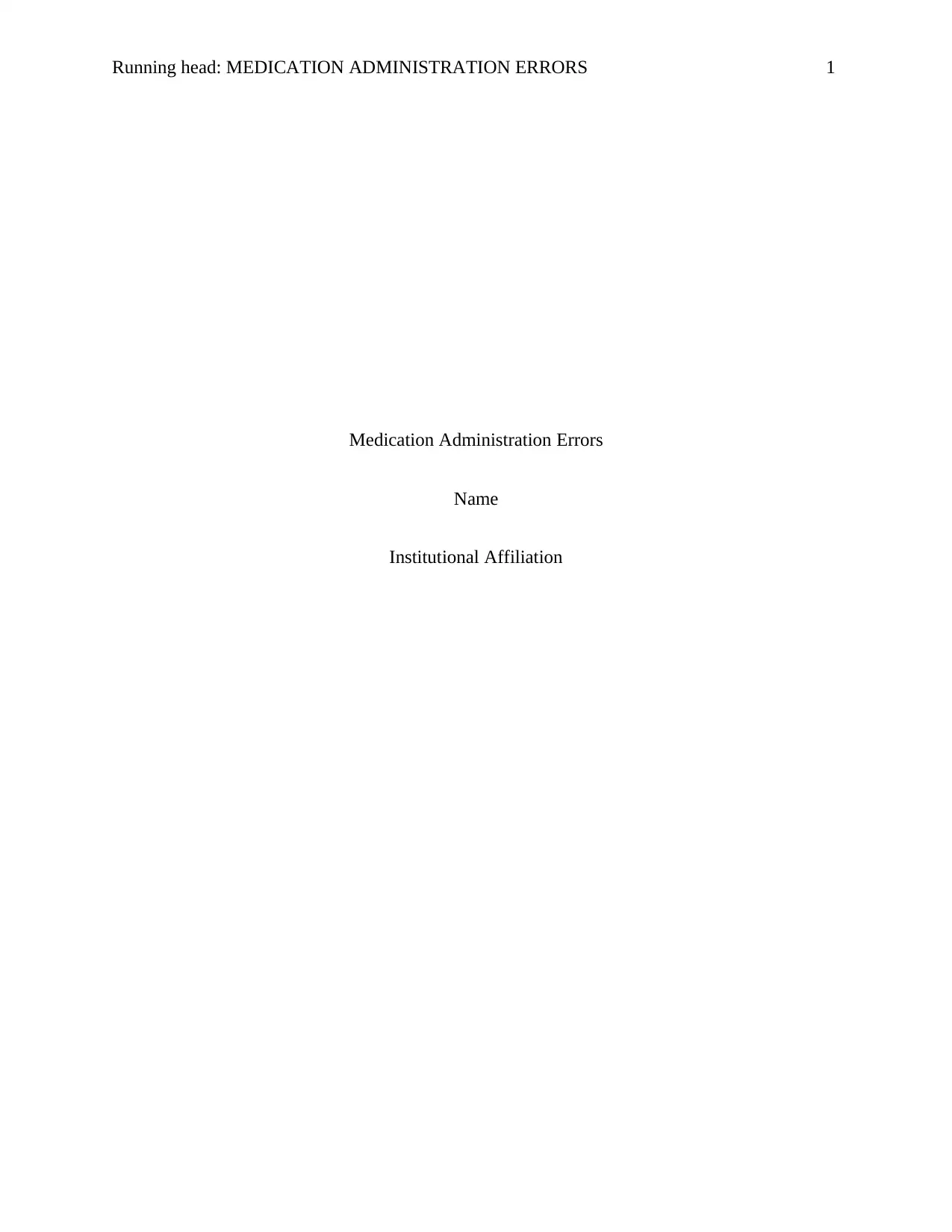
Running head: MEDICATION ADMINISTRATION ERRORS 1
Medication Administration Errors
Name
Institutional Affiliation
Medication Administration Errors
Name
Institutional Affiliation
Paraphrase This Document
Need a fresh take? Get an instant paraphrase of this document with our AI Paraphraser
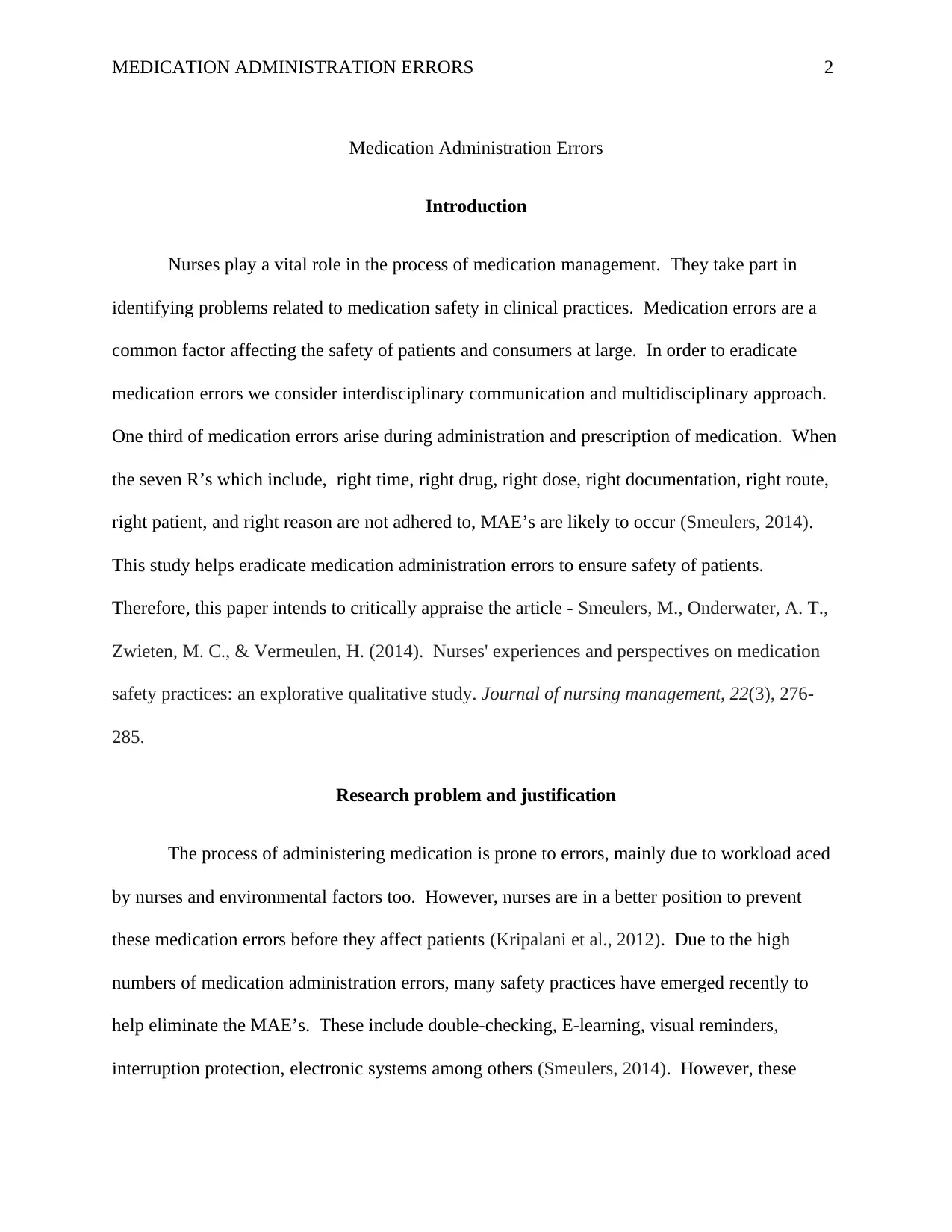
MEDICATION ADMINISTRATION ERRORS 2
Medication Administration Errors
Introduction
Nurses play a vital role in the process of medication management. They take part in
identifying problems related to medication safety in clinical practices. Medication errors are a
common factor affecting the safety of patients and consumers at large. In order to eradicate
medication errors we consider interdisciplinary communication and multidisciplinary approach.
One third of medication errors arise during administration and prescription of medication. When
the seven R’s which include, right time, right drug, right dose, right documentation, right route,
right patient, and right reason are not adhered to, MAE’s are likely to occur (Smeulers, 2014).
This study helps eradicate medication administration errors to ensure safety of patients.
Therefore, this paper intends to critically appraise the article - Smeulers, M., Onderwater, A. T.,
Zwieten, M. C., & Vermeulen, H. (2014). Nurses' experiences and perspectives on medication
safety practices: an explorative qualitative study. Journal of nursing management, 22(3), 276-
285.
Research problem and justification
The process of administering medication is prone to errors, mainly due to workload aced
by nurses and environmental factors too. However, nurses are in a better position to prevent
these medication errors before they affect patients (Kripalani et al., 2012). Due to the high
numbers of medication administration errors, many safety practices have emerged recently to
help eliminate the MAE’s. These include double-checking, E-learning, visual reminders,
interruption protection, electronic systems among others (Smeulers, 2014). However, these
Medication Administration Errors
Introduction
Nurses play a vital role in the process of medication management. They take part in
identifying problems related to medication safety in clinical practices. Medication errors are a
common factor affecting the safety of patients and consumers at large. In order to eradicate
medication errors we consider interdisciplinary communication and multidisciplinary approach.
One third of medication errors arise during administration and prescription of medication. When
the seven R’s which include, right time, right drug, right dose, right documentation, right route,
right patient, and right reason are not adhered to, MAE’s are likely to occur (Smeulers, 2014).
This study helps eradicate medication administration errors to ensure safety of patients.
Therefore, this paper intends to critically appraise the article - Smeulers, M., Onderwater, A. T.,
Zwieten, M. C., & Vermeulen, H. (2014). Nurses' experiences and perspectives on medication
safety practices: an explorative qualitative study. Journal of nursing management, 22(3), 276-
285.
Research problem and justification
The process of administering medication is prone to errors, mainly due to workload aced
by nurses and environmental factors too. However, nurses are in a better position to prevent
these medication errors before they affect patients (Kripalani et al., 2012). Due to the high
numbers of medication administration errors, many safety practices have emerged recently to
help eliminate the MAE’s. These include double-checking, E-learning, visual reminders,
interruption protection, electronic systems among others (Smeulers, 2014). However, these
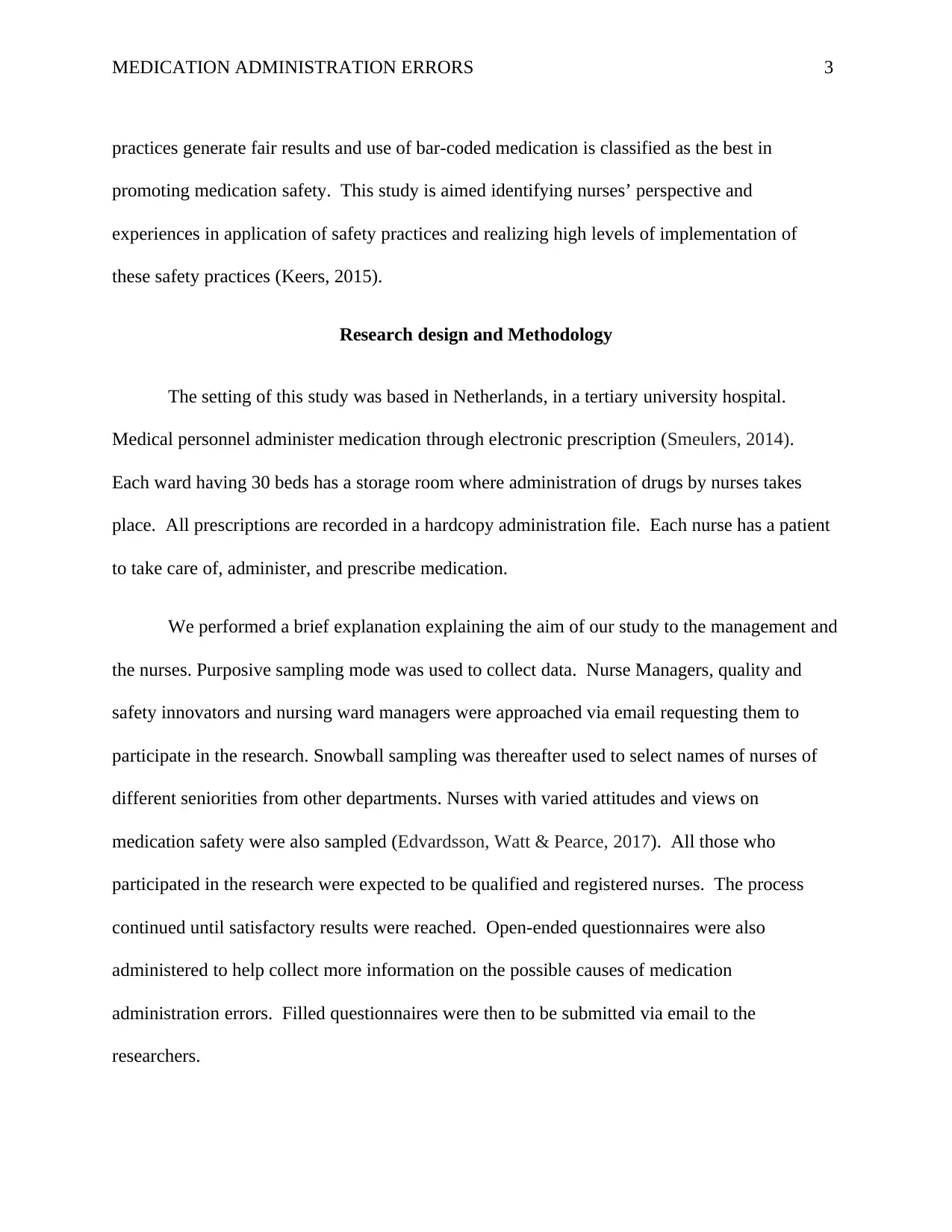
MEDICATION ADMINISTRATION ERRORS 3
practices generate fair results and use of bar-coded medication is classified as the best in
promoting medication safety. This study is aimed identifying nurses’ perspective and
experiences in application of safety practices and realizing high levels of implementation of
these safety practices (Keers, 2015).
Research design and Methodology
The setting of this study was based in Netherlands, in a tertiary university hospital.
Medical personnel administer medication through electronic prescription (Smeulers, 2014).
Each ward having 30 beds has a storage room where administration of drugs by nurses takes
place. All prescriptions are recorded in a hardcopy administration file. Each nurse has a patient
to take care of, administer, and prescribe medication.
We performed a brief explanation explaining the aim of our study to the management and
the nurses. Purposive sampling mode was used to collect data. Nurse Managers, quality and
safety innovators and nursing ward managers were approached via email requesting them to
participate in the research. Snowball sampling was thereafter used to select names of nurses of
different seniorities from other departments. Nurses with varied attitudes and views on
medication safety were also sampled (Edvardsson, Watt & Pearce, 2017). All those who
participated in the research were expected to be qualified and registered nurses. The process
continued until satisfactory results were reached. Open-ended questionnaires were also
administered to help collect more information on the possible causes of medication
administration errors. Filled questionnaires were then to be submitted via email to the
researchers.
practices generate fair results and use of bar-coded medication is classified as the best in
promoting medication safety. This study is aimed identifying nurses’ perspective and
experiences in application of safety practices and realizing high levels of implementation of
these safety practices (Keers, 2015).
Research design and Methodology
The setting of this study was based in Netherlands, in a tertiary university hospital.
Medical personnel administer medication through electronic prescription (Smeulers, 2014).
Each ward having 30 beds has a storage room where administration of drugs by nurses takes
place. All prescriptions are recorded in a hardcopy administration file. Each nurse has a patient
to take care of, administer, and prescribe medication.
We performed a brief explanation explaining the aim of our study to the management and
the nurses. Purposive sampling mode was used to collect data. Nurse Managers, quality and
safety innovators and nursing ward managers were approached via email requesting them to
participate in the research. Snowball sampling was thereafter used to select names of nurses of
different seniorities from other departments. Nurses with varied attitudes and views on
medication safety were also sampled (Edvardsson, Watt & Pearce, 2017). All those who
participated in the research were expected to be qualified and registered nurses. The process
continued until satisfactory results were reached. Open-ended questionnaires were also
administered to help collect more information on the possible causes of medication
administration errors. Filled questionnaires were then to be submitted via email to the
researchers.
⊘ This is a preview!⊘
Do you want full access?
Subscribe today to unlock all pages.

Trusted by 1+ million students worldwide
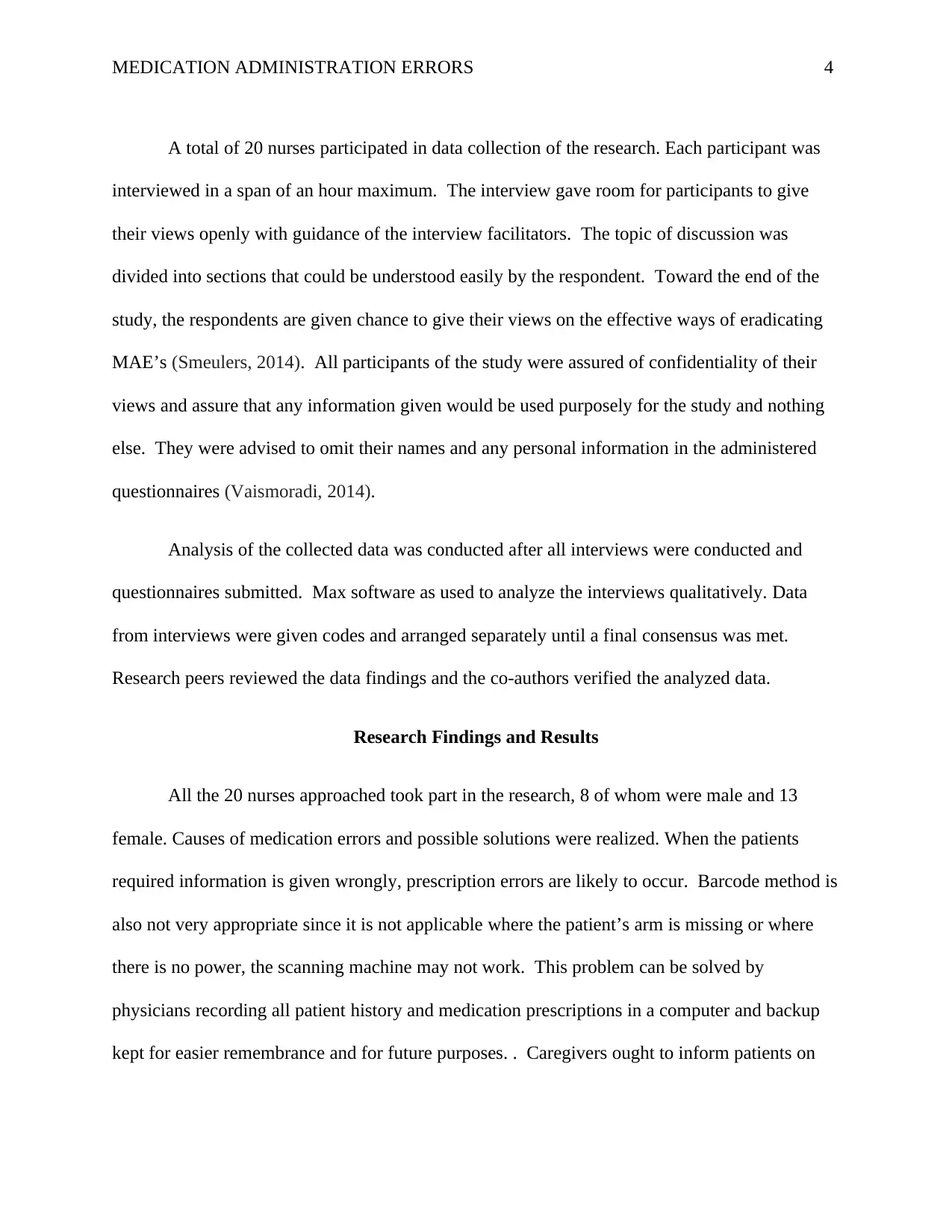
MEDICATION ADMINISTRATION ERRORS 4
A total of 20 nurses participated in data collection of the research. Each participant was
interviewed in a span of an hour maximum. The interview gave room for participants to give
their views openly with guidance of the interview facilitators. The topic of discussion was
divided into sections that could be understood easily by the respondent. Toward the end of the
study, the respondents are given chance to give their views on the effective ways of eradicating
MAE’s (Smeulers, 2014). All participants of the study were assured of confidentiality of their
views and assure that any information given would be used purposely for the study and nothing
else. They were advised to omit their names and any personal information in the administered
questionnaires (Vaismoradi, 2014).
Analysis of the collected data was conducted after all interviews were conducted and
questionnaires submitted. Max software as used to analyze the interviews qualitatively. Data
from interviews were given codes and arranged separately until a final consensus was met.
Research peers reviewed the data findings and the co-authors verified the analyzed data.
Research Findings and Results
All the 20 nurses approached took part in the research, 8 of whom were male and 13
female. Causes of medication errors and possible solutions were realized. When the patients
required information is given wrongly, prescription errors are likely to occur. Barcode method is
also not very appropriate since it is not applicable where the patient’s arm is missing or where
there is no power, the scanning machine may not work. This problem can be solved by
physicians recording all patient history and medication prescriptions in a computer and backup
kept for easier remembrance and for future purposes. . Caregivers ought to inform patients on
A total of 20 nurses participated in data collection of the research. Each participant was
interviewed in a span of an hour maximum. The interview gave room for participants to give
their views openly with guidance of the interview facilitators. The topic of discussion was
divided into sections that could be understood easily by the respondent. Toward the end of the
study, the respondents are given chance to give their views on the effective ways of eradicating
MAE’s (Smeulers, 2014). All participants of the study were assured of confidentiality of their
views and assure that any information given would be used purposely for the study and nothing
else. They were advised to omit their names and any personal information in the administered
questionnaires (Vaismoradi, 2014).
Analysis of the collected data was conducted after all interviews were conducted and
questionnaires submitted. Max software as used to analyze the interviews qualitatively. Data
from interviews were given codes and arranged separately until a final consensus was met.
Research peers reviewed the data findings and the co-authors verified the analyzed data.
Research Findings and Results
All the 20 nurses approached took part in the research, 8 of whom were male and 13
female. Causes of medication errors and possible solutions were realized. When the patients
required information is given wrongly, prescription errors are likely to occur. Barcode method is
also not very appropriate since it is not applicable where the patient’s arm is missing or where
there is no power, the scanning machine may not work. This problem can be solved by
physicians recording all patient history and medication prescriptions in a computer and backup
kept for easier remembrance and for future purposes. . Caregivers ought to inform patients on
Paraphrase This Document
Need a fresh take? Get an instant paraphrase of this document with our AI Paraphraser
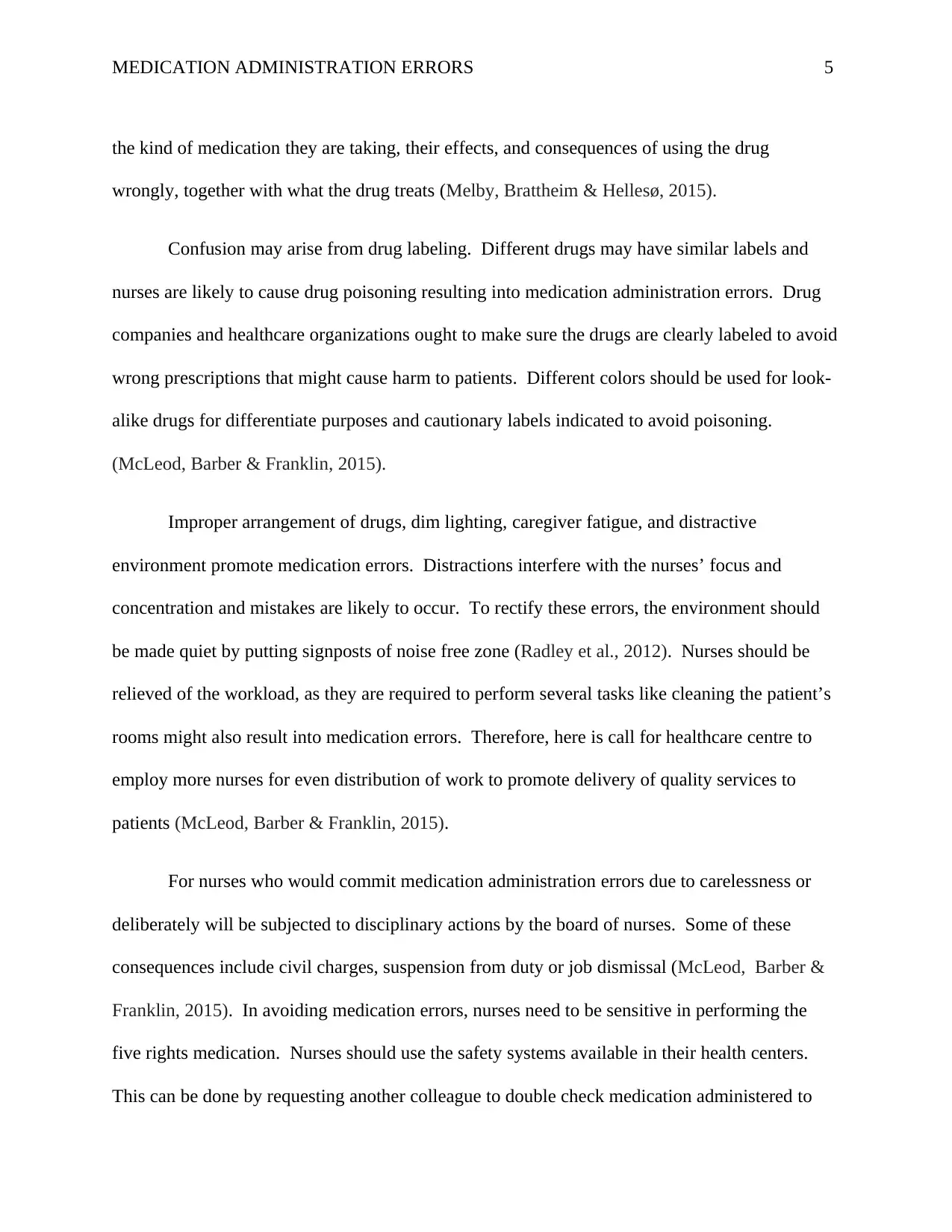
MEDICATION ADMINISTRATION ERRORS 5
the kind of medication they are taking, their effects, and consequences of using the drug
wrongly, together with what the drug treats (Melby, Brattheim & Hellesø, 2015).
Confusion may arise from drug labeling. Different drugs may have similar labels and
nurses are likely to cause drug poisoning resulting into medication administration errors. Drug
companies and healthcare organizations ought to make sure the drugs are clearly labeled to avoid
wrong prescriptions that might cause harm to patients. Different colors should be used for look-
alike drugs for differentiate purposes and cautionary labels indicated to avoid poisoning.
(McLeod, Barber & Franklin, 2015).
Improper arrangement of drugs, dim lighting, caregiver fatigue, and distractive
environment promote medication errors. Distractions interfere with the nurses’ focus and
concentration and mistakes are likely to occur. To rectify these errors, the environment should
be made quiet by putting signposts of noise free zone (Radley et al., 2012). Nurses should be
relieved of the workload, as they are required to perform several tasks like cleaning the patient’s
rooms might also result into medication errors. Therefore, here is call for healthcare centre to
employ more nurses for even distribution of work to promote delivery of quality services to
patients (McLeod, Barber & Franklin, 2015).
For nurses who would commit medication administration errors due to carelessness or
deliberately will be subjected to disciplinary actions by the board of nurses. Some of these
consequences include civil charges, suspension from duty or job dismissal (McLeod, Barber &
Franklin, 2015). In avoiding medication errors, nurses need to be sensitive in performing the
five rights medication. Nurses should use the safety systems available in their health centers.
This can be done by requesting another colleague to double check medication administered to
the kind of medication they are taking, their effects, and consequences of using the drug
wrongly, together with what the drug treats (Melby, Brattheim & Hellesø, 2015).
Confusion may arise from drug labeling. Different drugs may have similar labels and
nurses are likely to cause drug poisoning resulting into medication administration errors. Drug
companies and healthcare organizations ought to make sure the drugs are clearly labeled to avoid
wrong prescriptions that might cause harm to patients. Different colors should be used for look-
alike drugs for differentiate purposes and cautionary labels indicated to avoid poisoning.
(McLeod, Barber & Franklin, 2015).
Improper arrangement of drugs, dim lighting, caregiver fatigue, and distractive
environment promote medication errors. Distractions interfere with the nurses’ focus and
concentration and mistakes are likely to occur. To rectify these errors, the environment should
be made quiet by putting signposts of noise free zone (Radley et al., 2012). Nurses should be
relieved of the workload, as they are required to perform several tasks like cleaning the patient’s
rooms might also result into medication errors. Therefore, here is call for healthcare centre to
employ more nurses for even distribution of work to promote delivery of quality services to
patients (McLeod, Barber & Franklin, 2015).
For nurses who would commit medication administration errors due to carelessness or
deliberately will be subjected to disciplinary actions by the board of nurses. Some of these
consequences include civil charges, suspension from duty or job dismissal (McLeod, Barber &
Franklin, 2015). In avoiding medication errors, nurses need to be sensitive in performing the
five rights medication. Nurses should use the safety systems available in their health centers.
This can be done by requesting another colleague to double check medication administered to
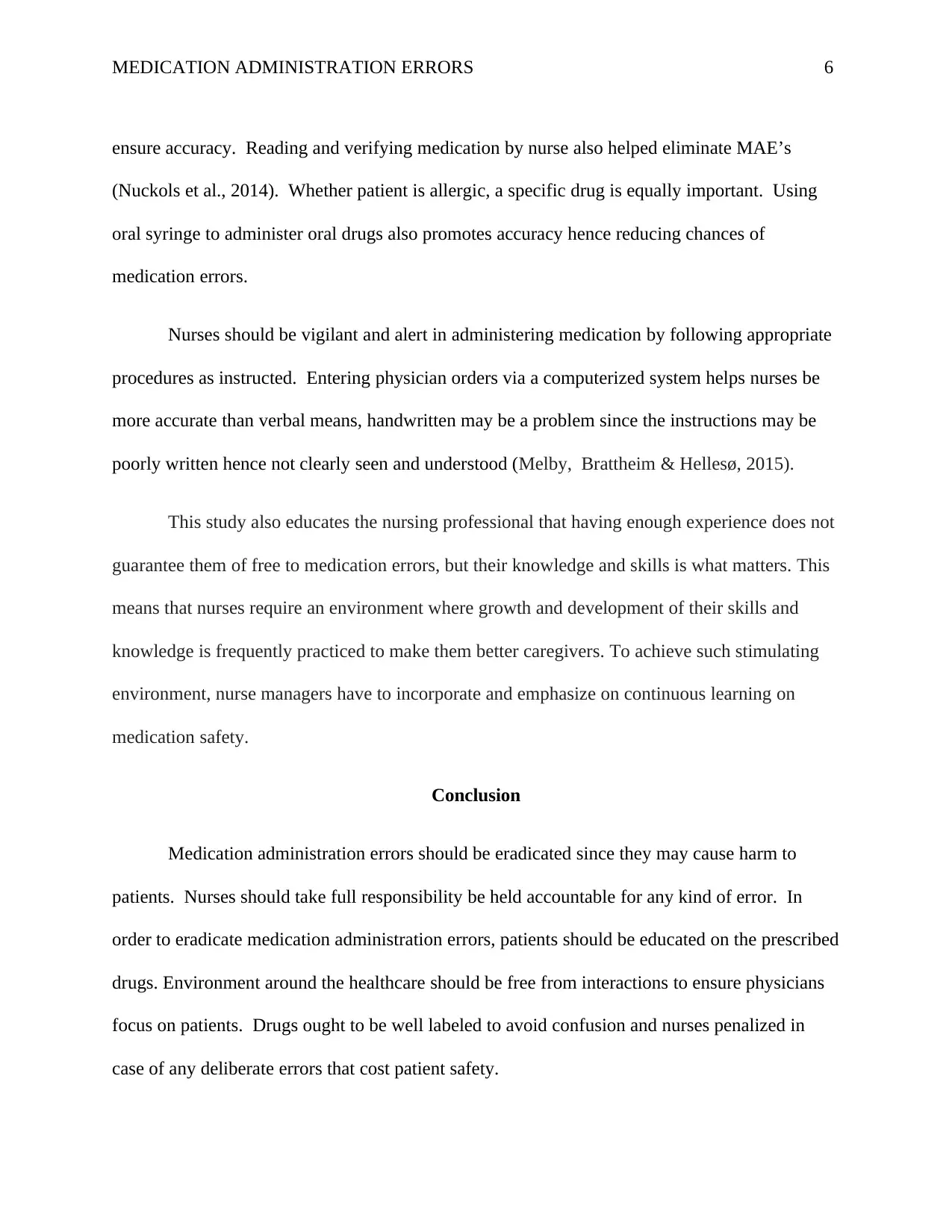
MEDICATION ADMINISTRATION ERRORS 6
ensure accuracy. Reading and verifying medication by nurse also helped eliminate MAE’s
(Nuckols et al., 2014). Whether patient is allergic, a specific drug is equally important. Using
oral syringe to administer oral drugs also promotes accuracy hence reducing chances of
medication errors.
Nurses should be vigilant and alert in administering medication by following appropriate
procedures as instructed. Entering physician orders via a computerized system helps nurses be
more accurate than verbal means, handwritten may be a problem since the instructions may be
poorly written hence not clearly seen and understood (Melby, Brattheim & Hellesø, 2015).
This study also educates the nursing professional that having enough experience does not
guarantee them of free to medication errors, but their knowledge and skills is what matters. This
means that nurses require an environment where growth and development of their skills and
knowledge is frequently practiced to make them better caregivers. To achieve such stimulating
environment, nurse managers have to incorporate and emphasize on continuous learning on
medication safety.
Conclusion
Medication administration errors should be eradicated since they may cause harm to
patients. Nurses should take full responsibility be held accountable for any kind of error. In
order to eradicate medication administration errors, patients should be educated on the prescribed
drugs. Environment around the healthcare should be free from interactions to ensure physicians
focus on patients. Drugs ought to be well labeled to avoid confusion and nurses penalized in
case of any deliberate errors that cost patient safety.
ensure accuracy. Reading and verifying medication by nurse also helped eliminate MAE’s
(Nuckols et al., 2014). Whether patient is allergic, a specific drug is equally important. Using
oral syringe to administer oral drugs also promotes accuracy hence reducing chances of
medication errors.
Nurses should be vigilant and alert in administering medication by following appropriate
procedures as instructed. Entering physician orders via a computerized system helps nurses be
more accurate than verbal means, handwritten may be a problem since the instructions may be
poorly written hence not clearly seen and understood (Melby, Brattheim & Hellesø, 2015).
This study also educates the nursing professional that having enough experience does not
guarantee them of free to medication errors, but their knowledge and skills is what matters. This
means that nurses require an environment where growth and development of their skills and
knowledge is frequently practiced to make them better caregivers. To achieve such stimulating
environment, nurse managers have to incorporate and emphasize on continuous learning on
medication safety.
Conclusion
Medication administration errors should be eradicated since they may cause harm to
patients. Nurses should take full responsibility be held accountable for any kind of error. In
order to eradicate medication administration errors, patients should be educated on the prescribed
drugs. Environment around the healthcare should be free from interactions to ensure physicians
focus on patients. Drugs ought to be well labeled to avoid confusion and nurses penalized in
case of any deliberate errors that cost patient safety.
⊘ This is a preview!⊘
Do you want full access?
Subscribe today to unlock all pages.

Trusted by 1+ million students worldwide
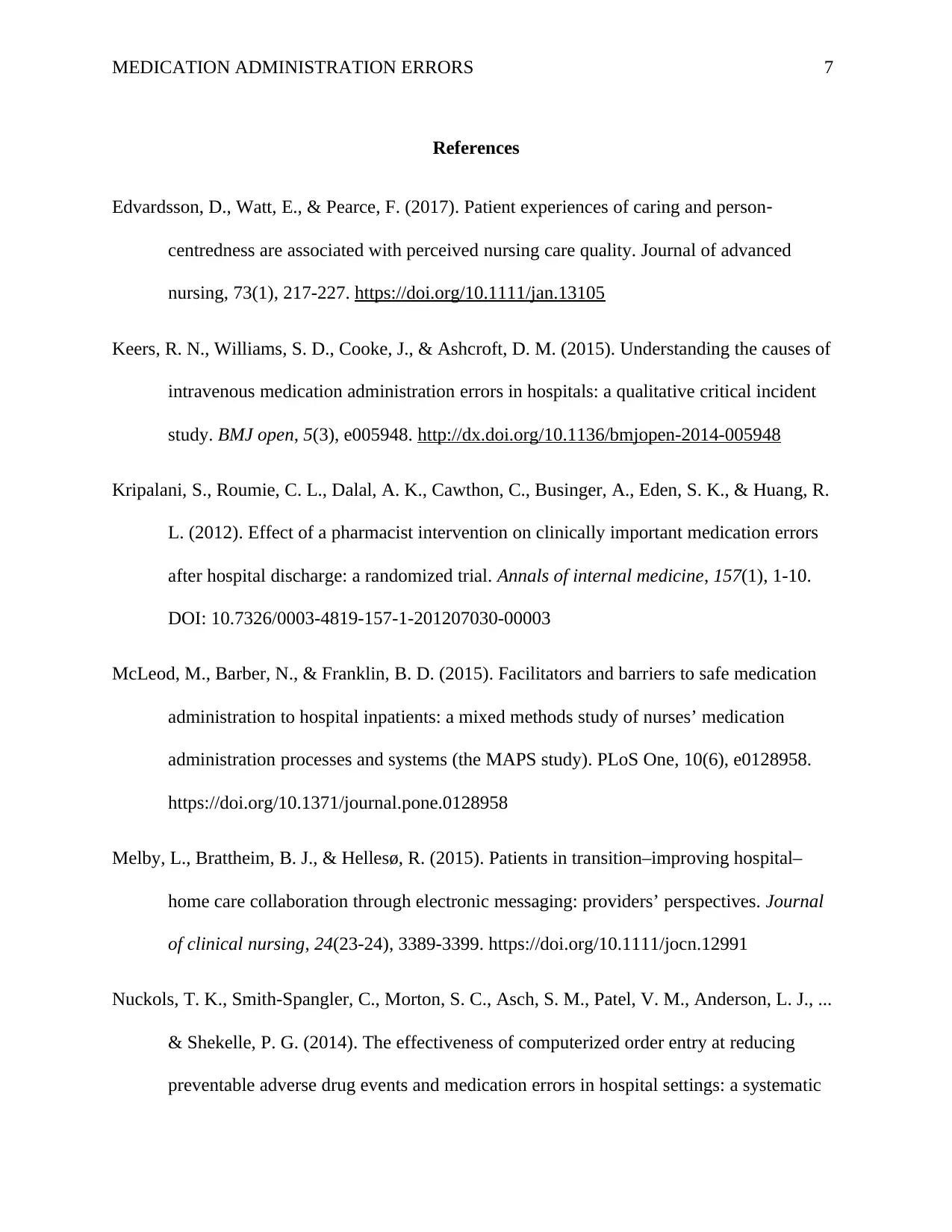
MEDICATION ADMINISTRATION ERRORS 7
References
Edvardsson, D., Watt, E., & Pearce, F. (2017). Patient experiences of caring and person‐
centredness are associated with perceived nursing care quality. Journal of advanced
nursing, 73(1), 217-227. https://doi.org/10.1111/jan.13105
Keers, R. N., Williams, S. D., Cooke, J., & Ashcroft, D. M. (2015). Understanding the causes of
intravenous medication administration errors in hospitals: a qualitative critical incident
study. BMJ open, 5(3), e005948. http://dx.doi.org/10.1136/bmjopen-2014-005948
Kripalani, S., Roumie, C. L., Dalal, A. K., Cawthon, C., Businger, A., Eden, S. K., & Huang, R.
L. (2012). Effect of a pharmacist intervention on clinically important medication errors
after hospital discharge: a randomized trial. Annals of internal medicine, 157(1), 1-10.
DOI: 10.7326/0003-4819-157-1-201207030-00003
McLeod, M., Barber, N., & Franklin, B. D. (2015). Facilitators and barriers to safe medication
administration to hospital inpatients: a mixed methods study of nurses’ medication
administration processes and systems (the MAPS study). PLoS One, 10(6), e0128958.
https://doi.org/10.1371/journal.pone.0128958
Melby, L., Brattheim, B. J., & Hellesø, R. (2015). Patients in transition–improving hospital–
home care collaboration through electronic messaging: providers’ perspectives. Journal
of clinical nursing, 24(23-24), 3389-3399. https://doi.org/10.1111/jocn.12991
Nuckols, T. K., Smith-Spangler, C., Morton, S. C., Asch, S. M., Patel, V. M., Anderson, L. J., ...
& Shekelle, P. G. (2014). The effectiveness of computerized order entry at reducing
preventable adverse drug events and medication errors in hospital settings: a systematic
References
Edvardsson, D., Watt, E., & Pearce, F. (2017). Patient experiences of caring and person‐
centredness are associated with perceived nursing care quality. Journal of advanced
nursing, 73(1), 217-227. https://doi.org/10.1111/jan.13105
Keers, R. N., Williams, S. D., Cooke, J., & Ashcroft, D. M. (2015). Understanding the causes of
intravenous medication administration errors in hospitals: a qualitative critical incident
study. BMJ open, 5(3), e005948. http://dx.doi.org/10.1136/bmjopen-2014-005948
Kripalani, S., Roumie, C. L., Dalal, A. K., Cawthon, C., Businger, A., Eden, S. K., & Huang, R.
L. (2012). Effect of a pharmacist intervention on clinically important medication errors
after hospital discharge: a randomized trial. Annals of internal medicine, 157(1), 1-10.
DOI: 10.7326/0003-4819-157-1-201207030-00003
McLeod, M., Barber, N., & Franklin, B. D. (2015). Facilitators and barriers to safe medication
administration to hospital inpatients: a mixed methods study of nurses’ medication
administration processes and systems (the MAPS study). PLoS One, 10(6), e0128958.
https://doi.org/10.1371/journal.pone.0128958
Melby, L., Brattheim, B. J., & Hellesø, R. (2015). Patients in transition–improving hospital–
home care collaboration through electronic messaging: providers’ perspectives. Journal
of clinical nursing, 24(23-24), 3389-3399. https://doi.org/10.1111/jocn.12991
Nuckols, T. K., Smith-Spangler, C., Morton, S. C., Asch, S. M., Patel, V. M., Anderson, L. J., ...
& Shekelle, P. G. (2014). The effectiveness of computerized order entry at reducing
preventable adverse drug events and medication errors in hospital settings: a systematic
Paraphrase This Document
Need a fresh take? Get an instant paraphrase of this document with our AI Paraphraser
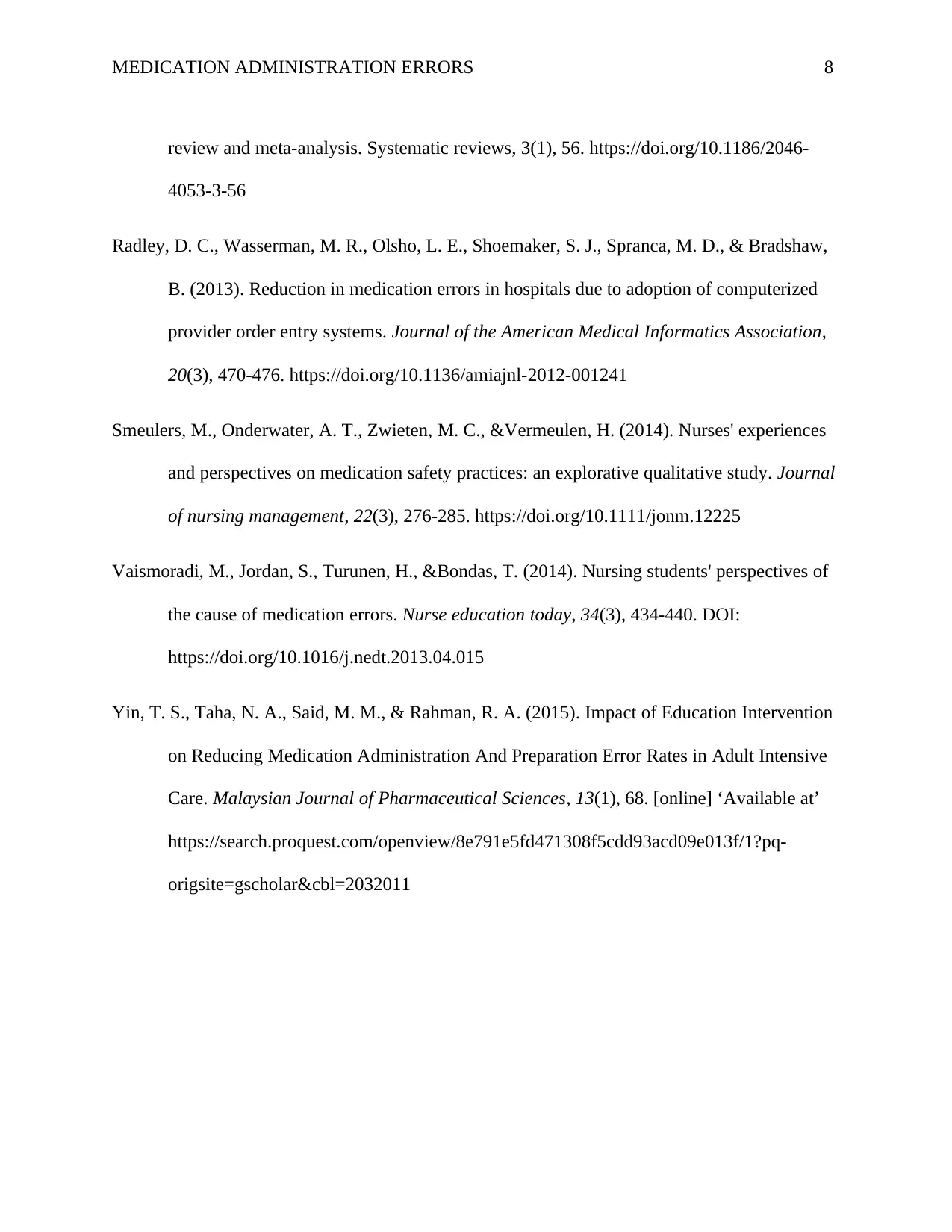
MEDICATION ADMINISTRATION ERRORS 8
review and meta-analysis. Systematic reviews, 3(1), 56. https://doi.org/10.1186/2046-
4053-3-56
Radley, D. C., Wasserman, M. R., Olsho, L. E., Shoemaker, S. J., Spranca, M. D., & Bradshaw,
B. (2013). Reduction in medication errors in hospitals due to adoption of computerized
provider order entry systems. Journal of the American Medical Informatics Association,
20(3), 470-476. https://doi.org/10.1136/amiajnl-2012-001241
Smeulers, M., Onderwater, A. T., Zwieten, M. C., &Vermeulen, H. (2014). Nurses' experiences
and perspectives on medication safety practices: an explorative qualitative study. Journal
of nursing management, 22(3), 276-285. https://doi.org/10.1111/jonm.12225
Vaismoradi, M., Jordan, S., Turunen, H., &Bondas, T. (2014). Nursing students' perspectives of
the cause of medication errors. Nurse education today, 34(3), 434-440. DOI:
https://doi.org/10.1016/j.nedt.2013.04.015
Yin, T. S., Taha, N. A., Said, M. M., & Rahman, R. A. (2015). Impact of Education Intervention
on Reducing Medication Administration And Preparation Error Rates in Adult Intensive
Care. Malaysian Journal of Pharmaceutical Sciences, 13(1), 68. [online] ‘Available at’
https://search.proquest.com/openview/8e791e5fd471308f5cdd93acd09e013f/1?pq-
origsite=gscholar&cbl=2032011
review and meta-analysis. Systematic reviews, 3(1), 56. https://doi.org/10.1186/2046-
4053-3-56
Radley, D. C., Wasserman, M. R., Olsho, L. E., Shoemaker, S. J., Spranca, M. D., & Bradshaw,
B. (2013). Reduction in medication errors in hospitals due to adoption of computerized
provider order entry systems. Journal of the American Medical Informatics Association,
20(3), 470-476. https://doi.org/10.1136/amiajnl-2012-001241
Smeulers, M., Onderwater, A. T., Zwieten, M. C., &Vermeulen, H. (2014). Nurses' experiences
and perspectives on medication safety practices: an explorative qualitative study. Journal
of nursing management, 22(3), 276-285. https://doi.org/10.1111/jonm.12225
Vaismoradi, M., Jordan, S., Turunen, H., &Bondas, T. (2014). Nursing students' perspectives of
the cause of medication errors. Nurse education today, 34(3), 434-440. DOI:
https://doi.org/10.1016/j.nedt.2013.04.015
Yin, T. S., Taha, N. A., Said, M. M., & Rahman, R. A. (2015). Impact of Education Intervention
on Reducing Medication Administration And Preparation Error Rates in Adult Intensive
Care. Malaysian Journal of Pharmaceutical Sciences, 13(1), 68. [online] ‘Available at’
https://search.proquest.com/openview/8e791e5fd471308f5cdd93acd09e013f/1?pq-
origsite=gscholar&cbl=2032011
1 out of 8
Related Documents
Your All-in-One AI-Powered Toolkit for Academic Success.
+13062052269
info@desklib.com
Available 24*7 on WhatsApp / Email
![[object Object]](/_next/static/media/star-bottom.7253800d.svg)
Unlock your academic potential
Copyright © 2020–2025 A2Z Services. All Rights Reserved. Developed and managed by ZUCOL.




